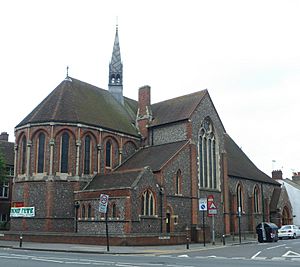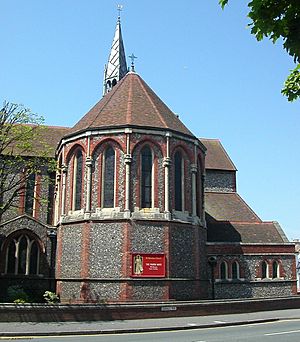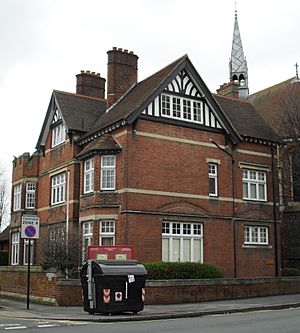St Barnabas Church, Hove facts for kids
Quick facts for kids St Barnabas Church, Hove |
|
|---|---|

The church from the northeast
|
|
| 50°50′05″N 0°10′39″W / 50.8346°N 0.1774°W | |
| Denomination | Church of England |
| Churchmanship | Anglo-catholic |
| History | |
| Dedication | St Barnabas |
| Administration | |
| Parish | Hove, St Barnabas |
| Deanery | Rural Deanery of Hove |
| Archdeaconry | Chichester |
| Diocese | Chichester |
| Province | Canterbury |
St Barnabas Church is an Anglican church located in Hove, which is part of the English city of Brighton and Hove. It was built between 1882 and 1883. The church was created to serve the many new families moving into the streets south and west of Hove railway station. The railway station had opened in 1865 and caused the area to grow quickly.
Contents
History of St Barnabas Church
A large estate called Preston Manor was sold in 1794. Over the next century, much of its land was used to build houses. Between 1865 and 1880, many homes were built south of the railway line connecting Brighton and Portsmouth. This new area was first called "West Brighton." Eventually, it became fully part of Hove.
Why a New Church Was Needed
In 1879, the old parish of Hove-cum-Preston was split into two smaller areas: Hove and Preston. The first vicar of the new Hove parish, Revd Thomas Pearcy, saw that a new church was needed. The number of people living in the area had grown by 10,000 between 1865 and 1880.
A meeting was held on March 14, 1881, at Hove town hall. A piece of land was offered for the church. It was bought for £1,500. Another meeting helped start a fundraising effort. By June 1881, £2,500 had been raised. The total cost to build the church was £6,500.
Building the Church
John Loughborough Pearson, a famous architect who had designed Truro Cathedral a few years earlier, was chosen to design St Barnabas Church in 1882. Construction began on May 27, 1882, and took one year to complete. The Bishop of Chichester laid the first stone. He then officially opened the new church on June 11, 1883.
Architecture and Design
John Loughborough Pearson designed many important churches. He thought St Barnabas was one of his smaller projects. He even called it "one of my cheap editions." However, St Barnabas Church is now a Grade II*-listed church. This means it is a very important historic building in Brighton and Hove.
Building Materials and Style
Like several other churches built in the late 1800s in the city, St Barnabas was built mainly with flint. Flint is a type of stone that was shaped to make flat pieces for building walls. The roof and windows are decorated with red bricks. The tall, narrow windows, called lancet windows, show styles from early English Gothic architecture.
Inside the Church
A house for the vicar, called a vicarage, was added next to the church in 1893 by different architects. In 1907, George Frederick Bodley, another architect known for his church designs, created a large reredos. This is a decorated screen behind the altar. It is a gilded (gold-covered) wooden triptych, which means it has three panels. The middle panel shows the Crucifixion. This was one of Bodley's last works.
Soon after the church was finished, choir stalls (seats for the choir) and a pulpit (a raised stand for preaching) were added. Both were made of oak wood. An alabaster (a type of stone) font was also installed. The church has several stained glass windows. One of these windows remembers the people who died in World War I. A tower was planned for the church's southwestern corner but was never built.
War Memorial
The church has a special gate called a lych gate. This gate serves as a war memorial. It remembers Victor Richardson, Roland Leighton, and Edward Brittain. These three friends were called the "Three Musketeers" in Vera Brittain's famous book about World War I, "Testament of Youth."
St Barnabas Church Today
St Barnabas Church was officially recognized as a Grade II*-listed building by English Heritage on September 10, 1971. As of February 2001, it was one of 70 Grade II*-listed buildings in the city of Brighton and Hove. There are 1,218 listed buildings of all grades in the city.
St Barnabas Church follows a "Modern Catholic" style of worship. This means they have Masses (church services) six days a week. They also offer other services, like prayer groups. There is a Sunday school each week for children.
In 1977, St Agnes Church, which was nearby, closed. Its parish (the area it served) was combined with St Barnabas. The parish of St Barnabas now covers a large area. It stretches across both sides of the railway line, going as far north as the A270 Old Shoreham Road.
See also



